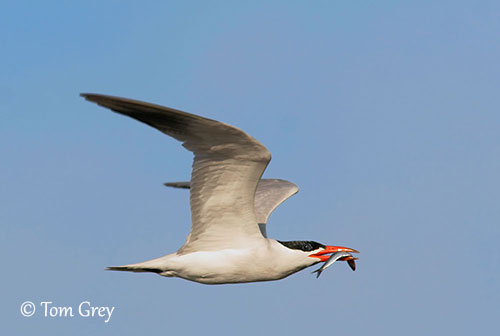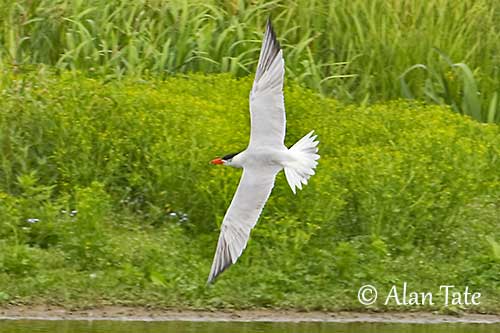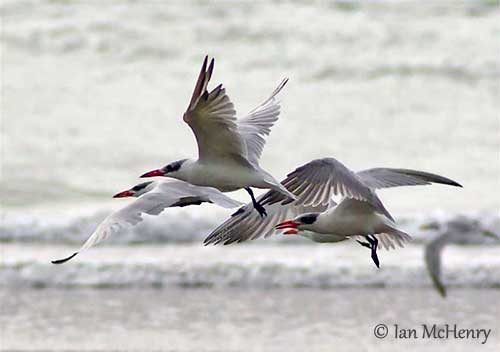
Fr: Sterne caspienne
Ang: Caspian Tern
All: Raubseeschwalbe
Esp: Pagaza Piquirroja
Ita: Sterna maggiore
Nd: Reuzenstern
Sd: skräntärna
Photographers:
Roger Ahlman
Pbase Galleries Peru and Ecuador & My bird pictures on IBC
Steve Garvie
RAINBIRDER Photo galleries & Flickr Rainbirder
Tom Grey
Tom Grey's Bird Pictures & Tom Grey's Bird Pictures 2
Ian McHenry
My New Zealand Birds
Alan & Ann Tate
AA Bird Photography
Ingo Waschkies
Bird Photography
Text by Nicole Bouglouan
Sources:
HANDBOOK OF THE BIRDS OF THE WORLD Vol 3 by Josep del Hoyo-Andrew Elliott-Jordi Sargatal - Lynx Edicions - ISBN : 8487334202
OISEAUX DE MER – Guide d’identification de Peter Harrison – Editions Broquet (Canada) – ISBN-10 : 2890004090 – ISBN-13 : 978-2890004092
Terns of Europe and North America Par Hans Larsson, Klaus Malling Olsen – Editeur: A&C Black, 2010 – ISBN: 1408131684, 9781408131688 – 224 pages
All About Birds (Cornell Lab of Ornithology)
The Birds of North America online
Animal Diversity Web (University of Michigan Museum of Zoology)
Wikipedia, the free encyclopaedia
What Bird-The ultimate Bird Guide (Mitchell Waite)
Bird Web (Seattle Audubon Society)
Birds in backyards (Birds Australia and Australian Museum)
Caspian Tern
Hydroprogne caspia
Charadriiformes Order – Laridae family
INTRODUCTION:
The Caspian Tern is the world’s largest tern, even larger than many gulls.
This species occurs on five continents where it breeds around large lakes and seacoasts. It feeds mainly on fish caught by diving after hovering over water and then plunging. It often forages on both freshwater lakes and sea. During the breeding season, it may become aggressive while defending the colony.
The Caspian Tern is threatened by disturbance at breeding colonies and habitat loss. The overall population trend is currently increasing, although some populations are stable or declining. But it is not globally threatened.

DESCRIPTION OF THE BIRD:
Biometrics:
Length: 48-56 cm
Wingspan: 127-140 cm
Weight: 530-782 g
The Caspian Tern in breeding plumage has pale grey upperparts including the wings, whereas underparts, rump and tail are white. The tail is slightly notched. On the wings, the primaries are dark grey to blackish on the underside.
On the head, the black cap extends to below the eye and onto the back of the head where the feathers may form a crest.
The large, stout bill is red, but the black tip may vary. The eyes are dark brown. Legs and feet are black.
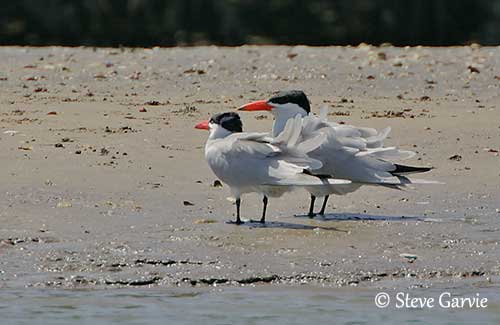
The non-breeding adult has the black head finely speckled with white.
Male and female are similar.
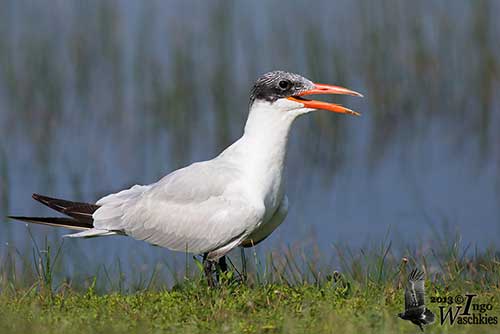
The juvenile has grey upperparts with brown scaled pattern, stronger on scapulars. The rump is greyish-white. The underparts are white. Tail and primaries are dark grey.
On the head, the pattern is similar to non-breeding adult, but it extends further down cheeks. The bill is mostly dull red-orange with dark tip.
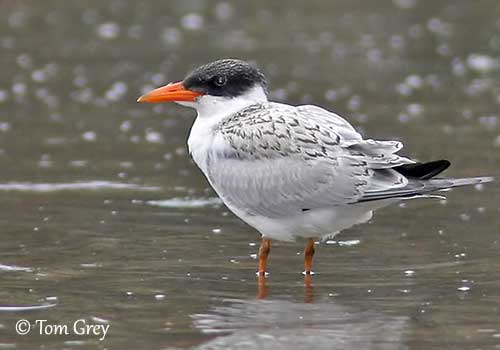
RANGE:
The Caspian Tern occurs on five continents. It can be found in North America, N Europe (especially Baltic), Africa, Madagascar, C and S Asia, coastal Australia but more sparsely inland, and New Zealand.
Young birds have been observed in delta of Copper R, probably indicating sometimes breeding in Alaska.
They disperse widely in winter and reach W Africa (Mali) and C Africa, and Middle East. Small numbers spend the winter on SW Spain and Portugal coasts, and a few individuals winter on the Spanish Mediterranean coast. Some thousands are resident in coastal Mauritania and N Senegal.
In Australia, adults and juveniles disperse widely.
In New Zealand, they also disperse north, travelling up to 1,150 kilometres.
In North America, the Great Lakes birds move S and E to winter in SE USA and Caribbean. The birds from W USA winter from C California to Mexico.
The Caspian Tern was observed in Ecuador with two individuals in December 2012 in La Segua, Manabí, and a small group in February 2013, also in La Segua, Manabí. A single bird was observed in October 2015 in La Tola, Purocongo, Esmeraldas. All the birds were in winter plumage.
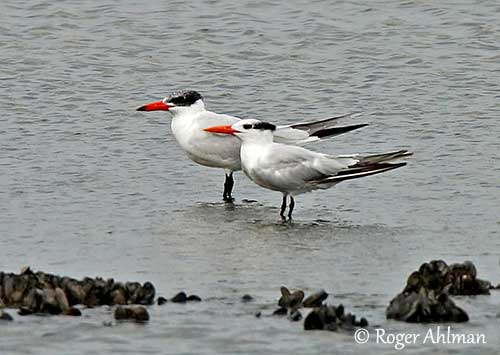
Caspian Tern with a Royal Tern
La Tola, Purocongo, Esmeraldas (Ecuador)
HABITAT:
The Caspian Tern usually frequents coastal habitats such as beaches, estuaries and marshes, and islands in large water bodies. They nest on sandy, muddy or pebbly shores, or in areas with only some vegetation on islands.
CALLS AND SONGS: SOUNDS BY XENO-CANTO
The Caspian Tern gives low, harsh “kraa” in flight, and a shorter “kow”.
When disturbed at colonies, the birds produce a loud barking in raucous unison “ra, ra, ra, raeu, rra”.
BEHAVIOUR IN THE WILD:
The Caspian Tern feeds primarily on fish, but insects, eggs and chicks of other bird species are also part of its diet.
It forages by flying over water at heights of 3 to 30 metres, often along the shoreline. It flies with the head down while searching for prey. Once a prey is located, it usually hovers for a moment, prior to the sharp dive. It may just skim the surface when diving, or it may submerge itself almost completely for a few seconds. It usually takes fish of about 9 centimetres, but also up to 25 centimetres long.
The prey is usually swallowed as soon as it is caught, except during the nesting period when the adults carry fish to the nest.
The Caspian Tern feeds in loose flocks and may sometimes become territorial, defending its feeding area. It is known for its habit of pirating food from other Laridae species.
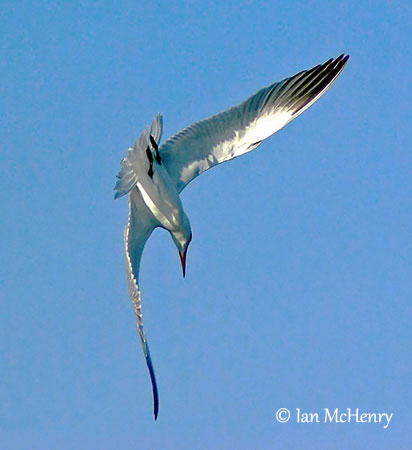
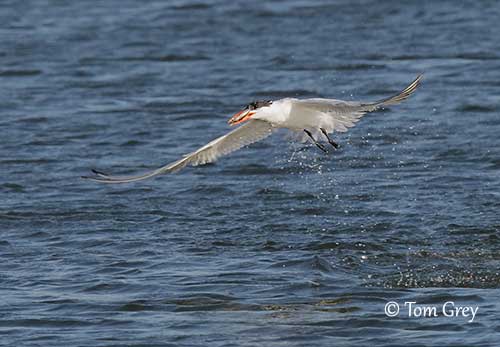
The Caspian Tern nests in colonies, but occasionally in isolated pairs too. Courtship feeding occurs, with the male offering a fish to the female on the ground. The male flies low over the colony while carrying the fish, followed by the female. This display is repeated several times to form the pair-bond, and it is followed by copulation.
The pair cements the bond by flying high in the air, ascending and diving together while calling. During the flight, the wings produce a soft, buzzing sound. They are monogamous at least for the season, and they nest on the ground.
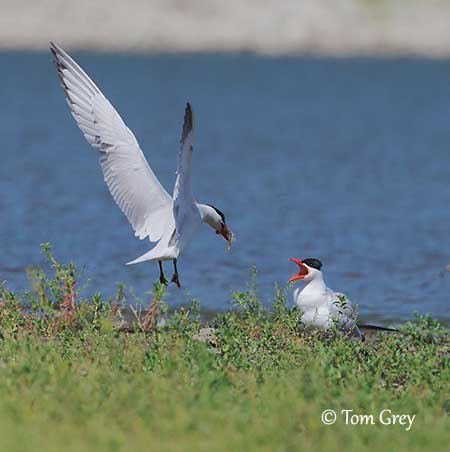
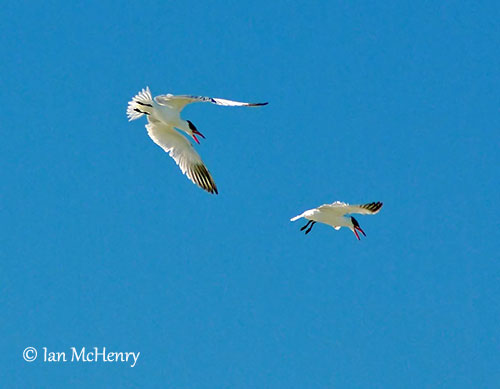
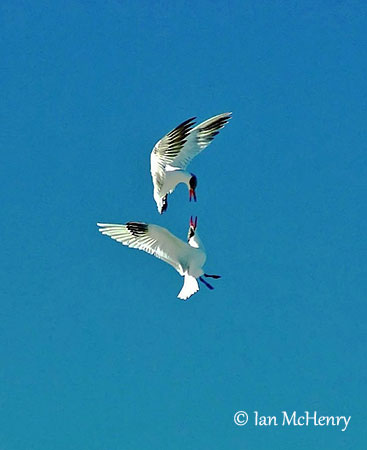
The Caspian Tern is migratory, although some populations are resident year-round (see RANGE).
The flight is strong, swift and graceful.
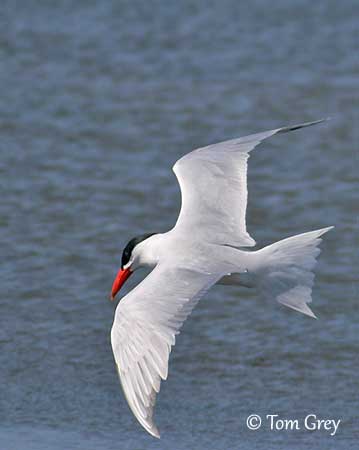
REPRODUCTION OF THIS SPECIES:
The breeding season occurs in April/June in N Hemisphere, and between September and December in S Hemisphere, and nearly year-round in N Australia.
The solitary pairs nest in gull or tern colonies but they exclude conspecifics from these colonies. However, the Caspian Tern is usually densely colonial, from 100 pairs to more than 1,000 pairs.
The nest is a scrape on the bare ground, often among debris or driftwood, or occasionally on floating mats of dead vegetation. The shallow depression may have a rim or a lining of debris.
The female lays 2-3 pale buff eggs with dark spots. Both adults share the incubation during 26-28 days. At hatching, the chicks have pale creamy-white down, but the plumage pattern may vary slightly among the young birds.
The chicks may leave the nest a few days after hatching, and they move to the nearby shore. However, some young remain at nest until they are able to fly, about 30-35 days after hatching. They are fed by both adults and remain in family group for up to 8 months.
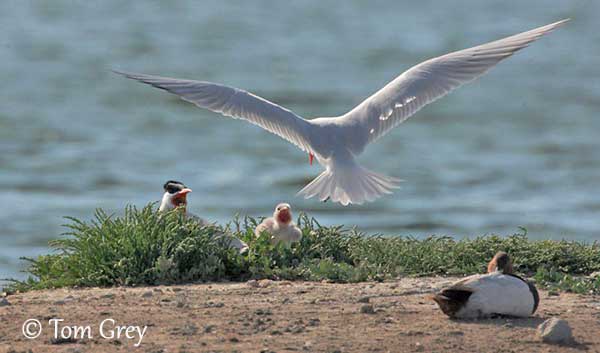
PROTECTION / THREATS / STATUS:
The Caspian Tern is vulnerable during the nesting period, and most predation is on eggs and chicks. Several predators such as the Bald Eagle, other Laridae species (especially gulls), Strigidae (owls), Corvidae (ravens), but also cats, dogs, coyotes, red foxes, raccoons and snakes. The terns are very aggressive against intruders, performing diving attacks and mobbing the predators together.
The Caspian Tern is threatened by human disturbance at colonies, and deterioration of the habitat by introduced exotic plants. Oil spills, marine pollution and fishing gears are important threats too.
The global population is estimated to number 250,000/470,000 individuals (2015). The trend is increasing, but some populations are stable or declining.
The Caspian Tern is not globally threatened and currently evaluated as Least Concern.
